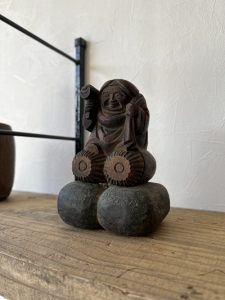大黒さまのルーツを知りびっくりするという。(愛知県名古屋市千種区姫池通 骨董買取 古美術風光舎名古屋店)
2022.12.14
こんにちは、スタッフYでござます。

このところ大黒さんが気になっておりまして。なんとも可愛らしい福々しい佇まいですよね。
大黒天、実はインド神話にルーツを持つ神様。
そのルーツを初めて知ったのですが、それにもましてご存知だったでしょうか、当初はなんと荒々しい破壊神の姿をしていたとのことです。それが中国を経て日本に伝わる中で打ち出の小槌に大袋を背負った現在の穏やかな姿になってきたのですが、現在では七福神の1人として知名度も高く、大黒天を祀るお寺も全国にたくさんありますね。
先にも述べました通り大黒天のルーツは日本ではなく、インドの神話にあります。大黒天はインドではサンスクリット語で「Mahākāla(マハーカーラ)」と呼ばれており、これはインド神話で破壊と再生を司る「シヴァ神」が、破壊神となったときの異名だそうです。
I have been wondering about Daikoku for a while now.
Daikokuten is a god with roots in Indian mythology, and I was a bit surprised when I first learned about his roots.
Did you know that Daikokuten was originally a fierce god of destruction? He is well known as one of the Seven Gods of Good Fortune, and there are many temples throughout Japan that worship Daikokuten.
As mentioned earlier, Daikokuten has its roots not in Japan but in Indian mythology. In Indian mythology, Daikokuten is called “Mahākāla” in Sanskrit, which is the alias of “Shiva,” the god of destruction and rebirth, when he became the god of destruction.
In Japan, the name “Daikokuten” is derived from the Japanese words “mahā” (big) and “kāla” (black). It is also called “makakara” from its Sanskrit sound.
The Mahakala, which is the root of Daikokuten, is characterized by its three faces and six arms. The body is often represented in blue or black. In mandalas and sculptures, he is depicted in various fighting poses, an example of which is as follows. The sword is held in the first hand of the right hand, and the first hand of the left hand is attached to the cutting edge. He also holds a human being in his second right hand, a sheep in his second left hand, and elephant skins in his third left and right hands. Daikokuten is the opposite of the Japanese Daikokuten, who is always smiling and chubby, and has a fearsome appearance.
Daikokuten was worshipped as “Kamado no kami” (god of the kitchen) in China, and thus Daikokuten came to be worshipped as the deity in charge of the kitchen kamado in Japan as well.
Daikoku-no-Mikoto is the deity of Izumo, known for its mythology of nation-building.
Since Daikoku-no-Mikoto was often represented as carrying a sack, it seems that Daikokuten in Japan came to be represented as a sack-carrier, similar to Daikoku-no-Mikoto, rather than as the rough-looking Mahakala of India.
In addition to his smiling face and his possessions, Daikokuten as depicted in modern Japan has a plump image, but Daikokuten, who had just been introduced to Japan, was still often depicted as a slender-looking deity.
This can be seen in the standing wooden statue of Daikokuten in the collection of Kanzeonji temple in Dazaifu, which is believed to have been made in the late Heian period (794-1185), with its slim figure and stern expression.
It is said that Daikokuten’s short stature and blessed appearance as we know it today is attributed to the Muromachi period (1336-1573), when the image of “Daikokuten = god of good fortune” began to take root.
Daikokuten is believed to bring blessings mainly related to money, such as a good harvest and prosperous business. The bag on Daikokuten’s left shoulder signifies treasures, the mallet in his right hand represents wealth, and the rice bale held by his foot signifies a bountiful harvest.
I really didn’t know that…. Gods have changed their appearance depending on the time period and the country they came from. Daikoku-sama looks very different.
********************
ご実家の整理やお片付けなどをされている方のご相談などが多くございます。
朝晩お寒くなってまいりましたので、お片付けなどくれぐれもご無理のないようになさってくださいませ。
風光舎では古美術品や骨董品の他にも絵画や宝石、趣味のお品など様々なジャンルのものを買受しております。
お片付けをされていて、こういうものでもいいのかしらと迷われているものでも、どうぞお気軽にご相談下さいませ。
また風光舎は、出張買取も強化しております。ご近所はもちろん、愛知県内、岐阜県、三重県その他の県へも出張いたします。
まずは、お電話お待ちしております。
愛知県名古屋市千種区姫池通
骨董 買取【古美術 風光舎 名古屋店】
TEL052(734)8444
10:00-17:00 OPEN
#骨董古美術買取#出張買取#高価買取#無料査定

